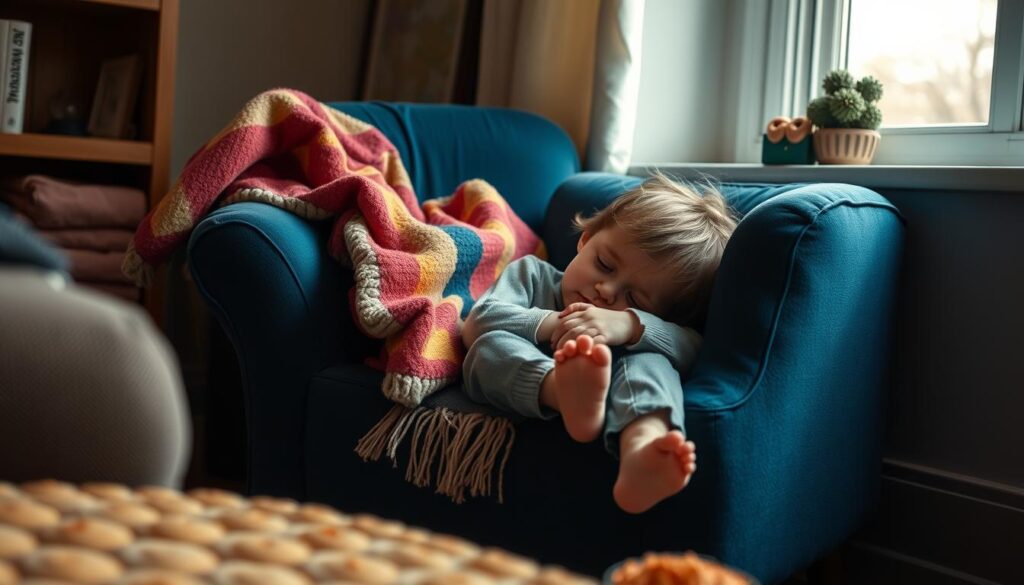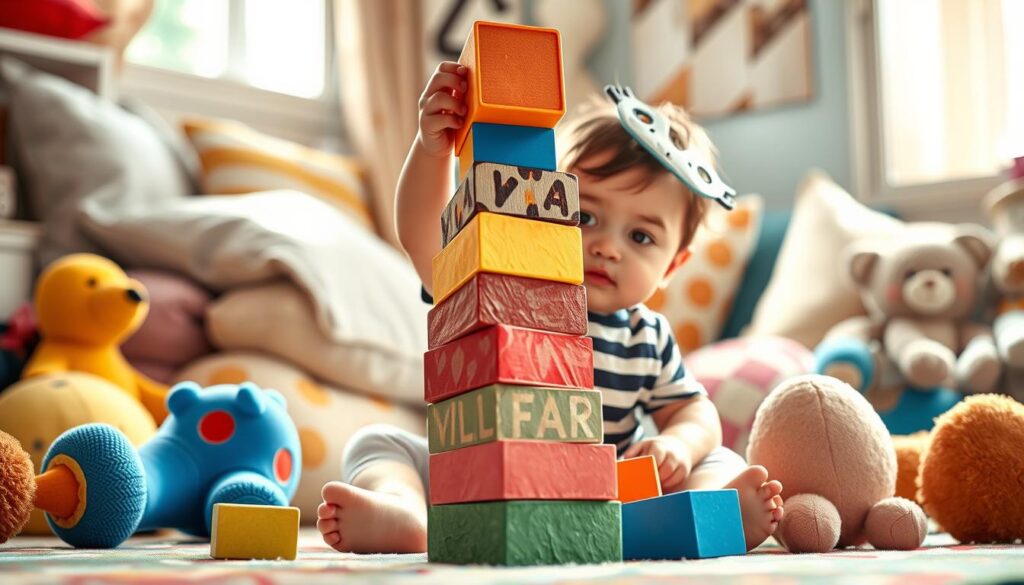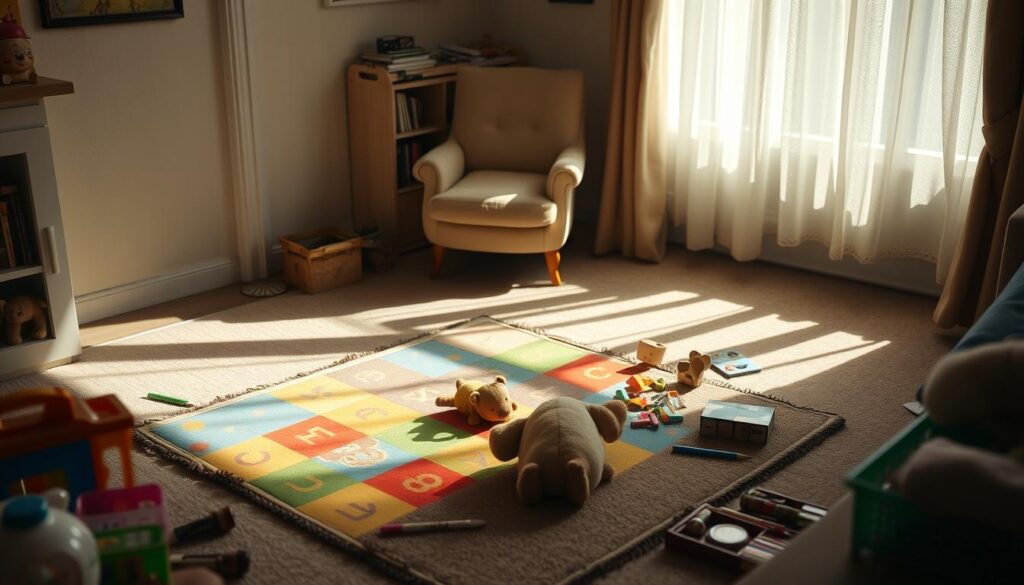As a parent, you’ve probably heard your toddler’s whining many times. It can be puzzling, especially when it happens around you. But don’t worry, you’re not alone. This article will explore the top 10 reasons for this behaviour, helping you understand and manage it better.
Imagine you’re cooking dinner, and your toddler starts whining for your attention. This is a common scene for many parents. But there are good reasons behind this behaviour.

Table of Contents
This article looks at why toddlers whine, from their need for comfort to their struggles with communication. It helps parents understand and manage this phase. Toddlers may strip naked for various reasons, like not understanding modesty or wanting control. Head-banging is common and usually harmless until about age 3. Breath-holding is a tantrum-like behaviour often due to feeling overwhelmed. Toddlers might enjoy bathwater because of the novelty of the experience. They explore by inserting objects into their nostrils or ears. Pretend play is vital for their development, and they often prefer simple items like boxes over toys. Food jags and picky eating are common in toddlers. Repetition of activities or stories helps them feel safe and develop skills. Toddlers seek independence by wandering but often return to their parents’ secure base. They imitate adults, like using electronic devices, to learn and connect. Toddlers may favour one parent over the other because each fulfils different needs.
Mummy’s the Centre of Attention
The Parent-Child Bond: Toddlers’ Innate Need for Maternal Comfort
Toddlers crave their mother’s attention and comfort deeply. They see their mum as their main source of security and comfort. Studies show that being held and cuddled boosts brain and body growth in babies.
Holding newborns helps control their body temperature and heartbeat. Cuddling also helps the mother relax and recover better after giving birth. A study found that a mother’s scent can calm a stressed baby. When they don’t get this comfort, they might whine to get their mum’s full attention. Knowing how important this bond is can help parents understand their child’s behaviour better.
Separation anxiety peaks between the ages of 10 and 18 months and usually vanishes by the age of three years. Babies up to 12 months old are still growing emotionally. They need lots of attention and care from their parents. Swaddling and baby wearing can calm fussy babies.
“Father-infant skin-to-skin contact was discovered to improve the infant’s behavioral response to pain and reduce paternal stress and anxiety.”
It takes about eight months for a baby to understand cause and effect of crying. Studies say letting a baby cry for a bit helps them learn to soothe themselves.
The bond between parents and children is key to toddlers’ need for comfort. By understanding and supporting this bond, parents can handle whining better.
Communication Difficulties
As your little one learns about language development, they might find it hard to communicate their needs and emotions. Whining is often a way for toddlers to show they’re frustrated because they can’t say what they want. Teaching them sign language or picture cues can help them express themselves without whining as much.
It’s key to help your toddler develop strong communication skills. When they can express themselves clearly, tantrums might decrease, and your bond will grow. Encourage them to use words, point, or gesture to show what they need. Be patient as they learn this important part of language development.
| Technique | Benefits |
|---|---|
| Sign Language | Helps toddlers communicate basic needs and feelings before they can speak fluently. |
| Picture Cues | Provides visual aids for toddlers to express themselves, reducing frustration. |
| Modelling | Demonstrates proper language use, encouraging toddlers to mimic and learn. |
By supporting your toddler’s communication skills and offering other ways to express themselves, you can reduce whining. Stay patient, be a good example, and celebrate their progress as they find their voice.

Developmental Milestone: Expressing Emotions
Toddlerhood is a key time for your child’s emotional growth. They are figuring out a world full of feelings, and whining is their way to show frustration or needs. Even though separation anxiety usually fades by three years old, your toddler might still whine as they try to express themselves.
Whining as a Way to Convey Frustration and Needs
Whining is your toddler’s way to say they’re overwhelmed, tired, or upset. By listening and comforting them, you help them find better ways to express themselves. It takes about eight months for a baby to understand why they cry, so be patient as they learn to ask for what they need.
“Holding a baby often, especially for comfort and reassurance, is unlikely to make them clingy,” according to experts.
As your toddler grows, they’ll find new ways to calm down. But until they’re three, they might still want to be held a lot. With your help, they’ll get through this exciting time of emotional growth with confidence.
| Behaviour | Explanation |
|---|---|
| Repetitive movements | Up to 70% of typically developing kids exhibit repetitive and seemingly purposeless movements like leg shaking, nail-biting, or hair twirling. |
| Thumb/finger sucking | Thumb or finger sucking continuing beyond age 2 to 4 might affect the shape of a child’s mouth or cause an orthodontic issue like an overbite. |
| Gum chewing | Research confirms that gum chewing increases alertness and enhances cognition. |
| Sensory-seeking behaviours | Kids who naturally rock, spin, swing, or bounce might have a vestibular system that requires more movement due to a lower-than-average sensitivity to stimuli. Specific toys can help fulfil these sensory needs. |
| Fidgeting | Fidgeting, such as touching, feeling, squeezing, and poking, helps feed a child’s hunger for touch and small movements. Fidgeting can also stimulate the brain and help children concentrate, particularly those with ADHD. |
Remember, your child’s emotional development is a journey, and with your understanding and support, they’ll learn to express their needs in a healthy way.
Attention-Seeking Behaviour
As your little one grows into a toddler, they might want all your attention. This can show up as whining. It’s because they crave your love and approval.
Newborns cry a lot, almost 3 hours a day, especially at 6-8 weeks. It’s important for them to bond with you. This bond is built through eye contact, smiling, and responding to their needs.
By responding gently and lovingly, you strengthen your bond. This positively affects your child’s growth and development.
Craving the Limelight: Mum’s Undivided Devotion
Your toddler might whine to get all your attention. This is normal in the parent-child relationship. Toddlers seek your love and approval.
Newborns sleep a lot, needing 14-17 hours in 24. They sleep in short bursts of 2-3 hours. They also need to eat every 2-4 hours in the early days.
To handle this, spend quality time with your child. Praise them for good behaviour. Also, teach them to play alone and soothe themselves.
Colic can make babies cry for no reason. If this happens, see a doctor. Newborns learn and explore a lot in their first few months. They start with simple things like lifting their head and then get more interested in their surroundings.
“Responding consistently, gently, and lovingly to a baby’s behavior helps in building a strong parent-child relationship, influencing the child’s development positively.”
Overtiredness and Hunger Pangs
As a parent, you know how hard it is when your toddler is overtired or hungry. They can’t control their emotions well, leading to lots of whining. This is because they can’t tell you what they need or how they feel.
Make sure your toddler sleeps enough and eats well to avoid these problems. A regular sleep schedule and watching for hunger signs can stop the tantrums. This way, your child learns to express their feelings better.
| Causes of Toddler Whining | Strategies to Minimize Whining |
|---|---|
| Overtiredness Hunger Difficulty Expressing Emotions Attention-Seeking Behavior | Establish a Consistent Sleep Routine Provide Regular, Healthy Snacks Teach Emotional Regulation Skills Allocate Dedicated One-on-One Time |
By tackling the reasons for toddler whining, like tiredness and hunger, you help them manage their feelings better. With patience and the right approach, you can make this tough time easier for both of you.

“Parenting a toddler is like a never-ending game of whack-a-mole, but with the right tools and a healthy dose of humour, you can turn those whines into wins.”
why do toddlers whine a lot around mom
The Enigma Unveiled: Mum’s Soothing Presence
Toddlers often whine more around their mothers because they seek comfort. They see their mothers as their main source of security. When they feel their needs aren’t met, they may whine.
Understanding this helps parents respond with empathy. They can find ways to deal with the whining.
Mum’s presence is very comforting for toddlers. They want her full attention and comfort. When they’re overwhelmed or frustrated, they go to their mothers for reassurance.
This need for their mother’s presence can lead to more whining. Toddlers use whining to show they want Mum’s full attention.
Research shows toddlers whine more around their mothers because they feel safe. Mum’s calm and support let toddlers feel secure to express their feelings. Even if it means whining sometimes.
By understanding why toddlers whine, parents can respond better. With patience and the right strategies, dealing with whining becomes easier. This strengthens the bond between mother and child.
Testing Boundaries
As your toddler grows, they might whine to test your rules. This is normal as they seek independence and want to make their own choices. By setting clear rules and letting them make choices, you help them feel independent and grow.
Testing boundaries is common in toddlerhood. It’s key to be patient and understanding. Your child is learning to be independent and needs your guidance.
Stay calm and consistent when they test boundaries. This helps them learn and grow. It also strengthens your bond and builds respect for each other.
| Parenting Strategies for Boundary Testing | Benefits |
|---|---|
| Consistent Enforcement of Rules and Limits | Helps your toddler understand expectations and feel secure |
| Providing Age-Appropriate Choices | Fosters a sense of autonomy and encourages decision-making skills |
| Maintaining Calm and Patient Responses | Models effective communication and emotional regulation |
| Encouraging Open Communication | Strengthens the parent-child bond and promotes understanding |
Embrace boundary testing with a positive attitude. This way, you can help your child grow and develop important skills.

Mimicking Behaviour
Monkey See, Monkey Do: Toddlers’ Imitation Game
As your toddler grows, they love to watch and copy what they see. This natural urge to imitate is key to their learning and growth. If they see you or others whining, they might start whining too.
But you can steer their behaviour in a good direction. By speaking calmly and praising them for good communication, you help them grow. This way, they learn to talk clearly and express their needs well.
Your toddler’s actions show what they learn from you. By being kind and setting a good example, you help them find better ways to show their feelings and needs.
As your toddler learns to communicate, support their natural copying. With your help and encouragement, they can speak up without whining. The secret is a loving parent-child bond that helps them grow and respect each other.
Separation Anxiety
Separation anxiety is common in toddlers and can lead to more whining. When a toddler is scared of being away from their mom, they might whine to get comfort. Parents can ease this by starting small separations, using comfort items, and reassuring their child they’ll be back.
Separation anxiety usually hits between 10 and 18 months and fades by three years old. Toddlers, especially, bond strongly with their main caregiver, often the mom. Whining is a way for them to show they’re scared of being apart and need their mom’s comfort.
- Using favourite toys or blankets can calm a child during separation.
- Having a set routine and slowly increasing time apart helps toddlers get used to being alone.
- Telling your child you’ll come back and keeping your promise builds trust and security.
Understanding why your toddler whines and using good parenting strategies can help. With time and consistency, the whining will lessen, and the bond between you and your child will grow stronger.

“Holding a baby, especially newborns, helps regulate their body temperature, heartbeat, and breathing.”
| Separation Anxiety Symptoms | Strategies to Manage Separation Anxiety |
|---|---|
| Clinging to parent Crying or whining when parent leaves Refusing to be left with other caregivers Difficulty sleeping or eating when parent is away | Introduce gradual separations Provide soothing transitional objects Reassure the child of your return Establish a predictable routine Encourage self-soothing techniques Seek professional support if needed |
By understanding your toddler’s needs and using good parenting strategies, you can handle separation anxiety. With patience and consistency, the whining will lessen, and your child will learn to cope with being apart.
Establishing Independence
As your little one grows, you might find yourself in a tug-of-war. They want to make their own choices and decisions. This is part of their journey towards independence. It can sometimes lead to them whining because they want to do things their way.
It’s a delicate balance, but with patience and calm, you can get through this. Give your toddler choices that fit their age. This lets them feel like they’re in charge, but still within your family’s rules.
When they try new things, be sure to praise them. This boosts their confidence and makes them feel capable.
The Tug-of-War: Mum’s Guidance vs. Toddler’s Autonomy
Your child’s whining is often a way to get your attention. It’s also a sign they’re trying to be more independent. By setting clear rules and listening with empathy, you help them express their needs better. Stay consistent and guide them gently towards finding their own answers.
The path to independence comes with its ups and downs. But with your support and a bit of creativity, you can help your child grow. Support their growing sense of self and their autonomy. All the while, keep being the loving, guiding parent you are.
Temperament and Personality Traits
Your toddler’s temperament and personality can greatly affect their tendency to whine. Some kids might be more emotional or prone to outbursts. Others might be more resilient and better at expressing their needs. Knowing your child’s unique traits helps you find the right approach to their whining.
Children who are more sensitive might struggle to control their emotions, leading to more whining. It’s common for young kids to be emotionally sensitive. They might not fully control their emotions until they’re 8 or 9. By understanding your child’s sensitivity, you can support them in finding better ways to communicate.
On the other hand, kids who are more independent might not whine as much. They might prefer to express their desires directly. These children might also be curious, which can sometimes lead to risky behaviours. Knowing your child’s temperament helps you tailor your parenting to meet their needs and reduce whining.
| Temperament Trait | Potential Impact on Toddler Behaviour |
|---|---|
| Sensitivity | Increased likelihood of whining and emotional outbursts due to difficulties in regulating emotions |
| Independence | Less inclined to whine, preferring to express desires directly, but may exhibit curiosity-driven behaviours that require supervision |
| Adaptability | Easier transition between activities and better ability to cope with changes, potentially reducing whining episodes |
| Intensity | Strong emotional reactions, both positive and negative, which may contribute to whining as a means of expression |
Understanding your toddler’s temperament and personality is key to managing their whining. You can offer emotional support, teach them coping skills, and encourage open communication. This helps them express their needs in a healthier way.
“The key to managing toddler whining is to recognise and respond to their individual temperament and personality, not one-size-fits-all solutions.”
Sensory Overload
As a parent, you might have seen your toddler whine more when they’re with you. This could be because of their sensory processing. Toddlers get overwhelmed by too much sensory input, like bright lights and loud noises.
When they feel too much, they might whine to cope. This is especially hard for kids on the autism spectrum, who might have meltdowns.
But, there are ways to help your toddler. You can make their environment calmer and give them breaks. This helps them feel better and communicate in a healthier way. Teaching them to breathe deeply or use a stress ball can also help them manage their feelings.
Every child is different, so it’s key to know what they need. By understanding sensory processing, you can find ways to help your toddler. With patience and understanding, you can help them deal with sensory challenges. This makes your relationship calmer and more peaceful.
Conclusion
Exploring toddler whining shows it’s not easy to find one answer. But, knowing why they whine helps you find ways to help. This includes understanding their need for comfort, reaching milestones, and their personality.
Being patient and understanding can help your toddler. You can teach them to communicate better and handle their feelings. Remember, growing up is a journey. By knowing why your toddler whines, you can handle it better.
Use what you’ve learned to make a safe space for your child to express themselves. Whining is a way for them to talk to you. With your help, they’ll learn to speak up and control their feelings. Stick with it, and the whining will lessen. This will strengthen your bond with your child.
FAQ
Why do toddlers whine a lot around their mothers?
Toddlers whine more around their mothers because they need comfort and attention. They see their mothers as their main source of security and comfort.
How can toddlers’ communication difficulties contribute to whining?
Toddlers may struggle to express their needs and feelings. This can lead them to whine as a way to communicate.
Is toddler whining related to emotional development?
Yes, whining is a way for toddlers to show frustration or unmet needs. It’s part of learning to handle their emotions.
Why do toddlers use whining to seek their mother’s attention?
Toddlers want their mother’s full attention. They may whine to get this attention, showing their need for love and approval.
Can factors like overtiredness and hunger contribute to toddler whining?
Yes, tiredness or hunger can make toddlers whine. They may not know how to express their discomfort in a better way.
How does the parent-child bond influence a toddler’s whining behaviour?
Toddlers see their mothers as their comfort and security. They may whine to get their mother’s attention when they feel unmet needs.
Do toddlers use whining to test boundaries?
Yes, toddlers may whine to test their parents’ rules. It’s a way for them to learn about boundaries and independence.
Can toddlers learn to whine by mimicking the behaviour of parents or siblings?
Yes, toddlers learn by watching. They may pick up whining from parents or older siblings and use it to communicate.
Does separation anxiety contribute to increased toddler whining?
Yes, separation anxiety can make toddlers whine. They may feel distressed when apart from their mother and whine to get comfort.
How does a toddler’s quest for independence influence their whining?
Toddlers whine when they want to be independent. It’s a way for them to assert their will and resist their mother’s guidance.
Can a toddler’s temperament and personality traits affect their propensity for whining?
Yes, a toddler’s temperament and personality can make them more likely to whine. Some children are naturally more sensitive or prone to outbursts.
How can sensory stimuli impact a toddler’s whining behaviour?
Overwhelming sensory stimuli, like bright lights or loud noises, can make toddlers whine. It’s a way for them to cope with stress and overstimulation.

